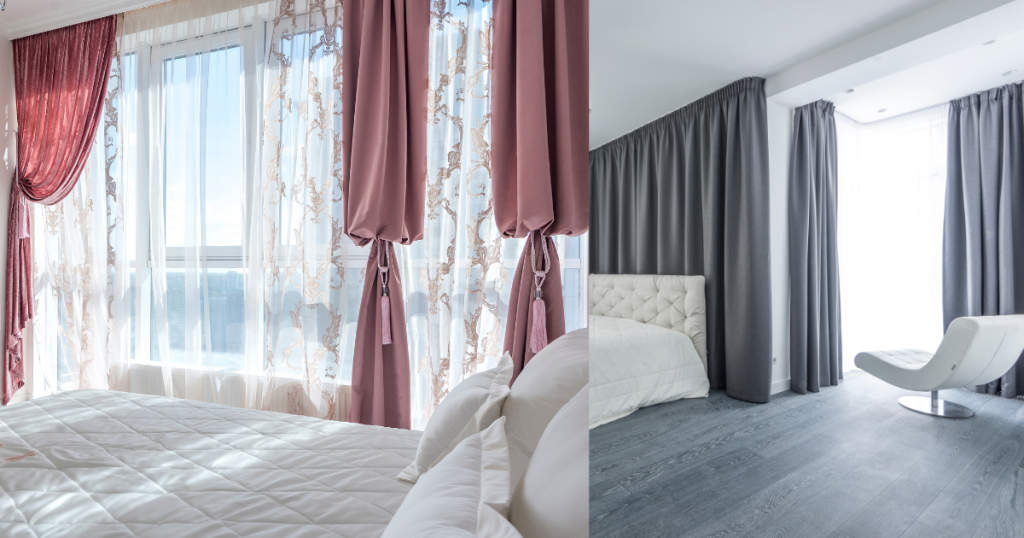In the case of window treatment, the terms drapes and curtains are used interchangeably. Although they both make your home slightly prettier and more useful, they are not exactly the same. Drapes and curtains are two distinct items that can be discussed to make a correct decision regarding the use of each.
What Are Drapes or Curtains?
Curtains are light, casual, and airy, perfect for letting in natural light. Drapes are heavy, formal, and lined, ideal for blocking light, adding privacy, and creating a luxurious feel in living rooms or bedrooms.
In this Guide:
- how to hang curtains or Drapes?
- how to measure for curtains or Drapes?
- should curtains touch the floor or Drapes?
- how to measure curtains or Drapes?
- how high to hang curtains or Drapes?
- how long should curtains be or Drapes?
How to Hang Curtains or Drapes?
Install the curtain rod 4–6 inches above the window frame or closer to the ceiling for a taller look.Extend the rod 6–12 inches beyond each side of the window so panels can fully open.Hang curtains or drapes so they fall evenly, either just touching the floor or slightly puddling for a formal style.
How to Measure for Curtains or Drapes
Width: Measure the window frame and add 6–12 inches to each side. Multiply by 1.5–3 for fullness.
Height: Measure from the top of the rod placement to where you want the fabric to fall (sill, below sill, or floor).
Should Curtains or Drapes Touch the Floor?
Curtains: In casual spaces (kitchens, kids’ rooms), they can end at the sill or just below. In living rooms/bedrooms, floor-length looks best.
Drapes: Almost always touch the floor, often with a slight puddle for an elegant effect.
How to Measure Curtains or Drapes
Curtains and drapes are measured width × length.
Width = each panel’s measurement (you’ll usually need 2 panels).
Length = from rod to sill, below sill, or floor — depending on preference.
How High to Hang Curtains or Drapes
Standard: 4–6 inches above the window frame.
For tall ceilings: just below the ceiling line.
For a dramatic look: extend rods wide and high so the window looks bigger.
How Long Should Curtains or Drapes Be?
Sill length – Ends at the sill (casual).
Apron length – Ends a few inches below sill.
Floor length – Just touching the floor (most common).
Puddled length – Drapes extend 2–4 inches onto the floor (luxurious, formal).
Drapes vs. Curtains: Side-by-Side Comparison
| Feature | Curtains | Drapes |
|---|---|---|
| Fabric Weight | Light to medium | Heavy and lined |
| Light Control | Filters light | Blocks light, provides privacy |
| Style | Casual and versatile | Formal and elegant |
| Length | Usually window length | Floor-length or longer |
| Maintenance | Easy to clean, often washable | Requires dry cleaning |
| Best For | Living rooms, kitchens, kids’ rooms | Bedrooms, formal spaces, offices |
Which One Should You Choose?
- Go With Curtains When: You would prefer a casual, light, and naturally dayed appearance that is simple to care for. They can be put in their day-to-day use and easily replaced with a seasonal update.
- Select Drapes When: You want a rich, dramatic appearance that is more practical in terms of privacy, insulation, and being able to turn on or turn off all the lights. Bedrooms or rooms where you desire a formal effect are best suited to use drapes.
Final Thoughts
Curtains and drapes help to improve the appearance of your house and also include a functional use. It all depends on your personal preference, what the room requires and the degree of formality you wish. When you want something easy and light, use the curtains. Drapes are the best way to be elegant and functional.







